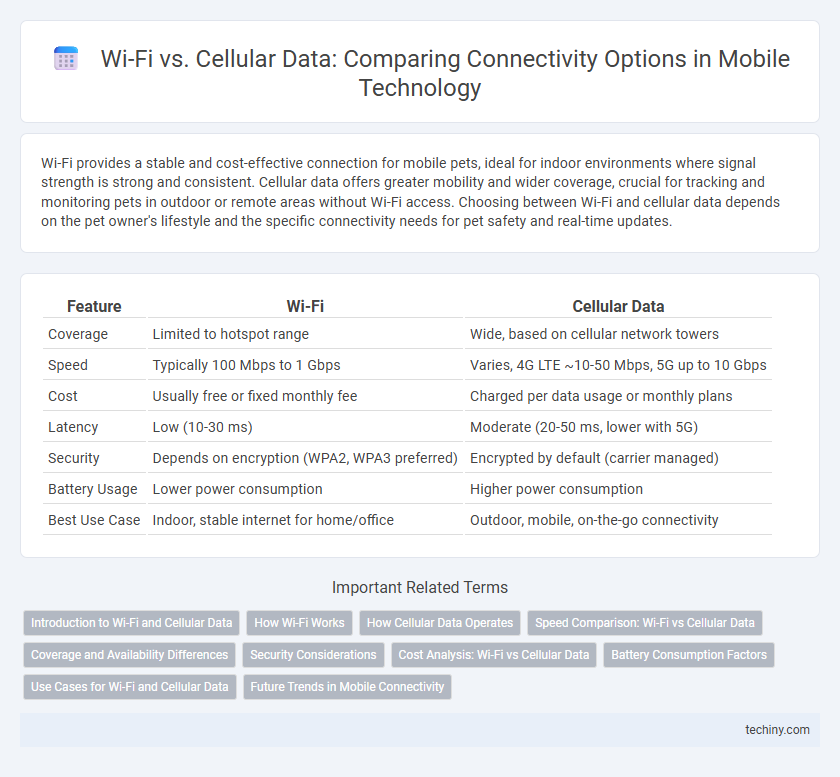Wi-Fi provides a stable and cost-effective connection for mobile pets, ideal for indoor environments where signal strength is strong and consistent. Cellular data offers greater mobility and wider coverage, crucial for tracking and monitoring pets in outdoor or remote areas without Wi-Fi access. Choosing between Wi-Fi and cellular data depends on the pet owner's lifestyle and the specific connectivity needs for pet safety and real-time updates.
Table of Comparison
| Feature | Wi-Fi | Cellular Data |
|---|---|---|
| Coverage | Limited to hotspot range | Wide, based on cellular network towers |
| Speed | Typically 100 Mbps to 1 Gbps | Varies, 4G LTE ~10-50 Mbps, 5G up to 10 Gbps |
| Cost | Usually free or fixed monthly fee | Charged per data usage or monthly plans |
| Latency | Low (10-30 ms) | Moderate (20-50 ms, lower with 5G) |
| Security | Depends on encryption (WPA2, WPA3 preferred) | Encrypted by default (carrier managed) |
| Battery Usage | Lower power consumption | Higher power consumption |
| Best Use Case | Indoor, stable internet for home/office | Outdoor, mobile, on-the-go connectivity |
Introduction to Wi-Fi and Cellular Data
Wi-Fi technology enables wireless internet access by connecting devices to a local area network through radio waves, commonly used in homes, offices, and public hotspots. Cellular data provides internet connectivity via mobile networks, allowing smartphones and tablets to access the internet on the move through 3G, 4G, and 5G technologies. Both Wi-Fi and cellular data serve distinct roles in mobile technology, balancing speed, coverage, cost, and mobility for users.
How Wi-Fi Works
Wi-Fi operates by transmitting data through radio waves between a device and a wireless router connected to an internet source, typically a modem. It uses the IEEE 802.11 standards to enable devices within a local area to communicate without physical cables, allowing seamless internet access. Wi-Fi networks rely on frequency bands such as 2.4 GHz and 5 GHz to optimize signal strength and minimize interference.
How Cellular Data Operates
Cellular data operates through a network of cell towers that transmit radio signals to mobile devices using licensed spectrum bands, enabling internet access almost anywhere within coverage zones. This technology relies on standards such as 4G LTE and 5G, which provide varying speeds, latency, and bandwidth, supporting seamless connectivity for applications like streaming, browsing, and real-time communication. Data is routed through mobile network operators' infrastructure, incorporating core network elements such as the Packet Gateway (PGW) and Serving Gateway (SGW) to manage data traffic efficiently and ensure secure connections.
Speed Comparison: Wi-Fi vs Cellular Data
Wi-Fi generally offers faster download and upload speeds compared to cellular data, with typical Wi-Fi networks delivering speeds ranging from 50 Mbps to over 1 Gbps depending on the router and internet service provider. Cellular data speeds vary significantly by technology generation, with 4G LTE providing average speeds around 10-50 Mbps, while 5G networks can exceed 1 Gbps under optimal conditions. Latency is usually lower on Wi-Fi networks, enhancing real-time applications like gaming and video calls, whereas cellular connections may experience higher latency due to network congestion and signal variability.
Coverage and Availability Differences
Wi-Fi typically offers limited coverage confined to specific areas such as homes, offices, or public hotspots, relying on fixed infrastructure for connectivity. Cellular data provides extensive coverage through cellular towers, enabling mobile internet access across urban, suburban, and many rural regions. While Wi-Fi often delivers faster speeds in localized environments, cellular networks ensure broader availability and seamless on-the-move connectivity.
Security Considerations
Wi-Fi networks, especially public and unsecured ones, pose significant risks such as data interception, man-in-the-middle attacks, and unauthorized access. Cellular data offers enhanced security through encryption protocols like LTE and 5G, which provide greater protection against eavesdropping and hacking attempts. For sensitive transactions and communications, using cellular data is generally safer, while VPN usage can help mitigate some Wi-Fi security vulnerabilities.
Cost Analysis: Wi-Fi vs Cellular Data
Wi-Fi generally offers a more cost-effective solution for mobile internet access due to its flat-rate pricing and unlimited usage in most cases, while cellular data plans frequently impose data caps and higher charges, especially for high data consumption. Cellular data costs vary significantly by provider and region, often leading to expensive overages or throttled speeds once the allocated data limit is exceeded. Businesses and consumers seeking affordable, high-bandwidth connectivity typically rely on Wi-Fi at fixed locations, reserving cellular data primarily for mobility and backup scenarios.
Battery Consumption Factors
Wi-Fi generally consumes less battery compared to cellular data due to lower transmission power requirements, especially when connected to a strong, stable network. Cellular data usage increases battery drain significantly in areas with weak signal strength as the device amplifies power to maintain connection. Background app activity and data-intensive tasks exacerbate battery consumption on cellular networks compared to Wi-Fi.
Use Cases for Wi-Fi and Cellular Data
Wi-Fi is ideal for high-bandwidth activities like video streaming, online gaming, and large file downloads typically performed in fixed locations such as homes, offices, or cafes. Cellular data is optimal for on-the-go connectivity, enabling tasks like GPS navigation, social media updates, and real-time communication in areas without Wi-Fi access. Combining both technologies ensures seamless internet access by leveraging Wi-Fi's high speed and low cost indoors and cellular data's broad coverage outdoors.
Future Trends in Mobile Connectivity
Emerging 5G and upcoming 6G networks will significantly enhance cellular data speeds and reliability, outpacing traditional Wi-Fi standards like Wi-Fi 6 and 6E in mobile environments. The integration of AI-driven network management and edge computing will optimize data traffic across both Wi-Fi and cellular networks, ensuring seamless handoff and reduced latency. Future mobile connectivity will emphasize hybrid solutions combining the strengths of Wi-Fi's local bandwidth with cellular networks' broader coverage for smarter, faster, and more resilient digital experiences.
Wi-Fi vs Cellular Data Infographic

 techiny.com
techiny.com